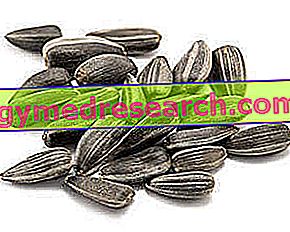What's this
What is passion fruit or maracujá?
The passion fruit is an acidulous fruit, sweet, fragrant and exotic, known above all for its unique organoleptic and taste characteristics.

Also known as maracujá, it belongs to both the VII and the VI fundamental group of foods - rich in vitamin C (ascorbic acid) and pro-vitamin A (carotenoids, retinol equivalents / RAE); also abound: water, fibers, fructose and certain minerals - for example potassium and iron (not very bioavailable). In the context of sweet acidulous fruits, the energy intake of maracujá could be defined as medium. Yellow maracujá contains small concentrations of cyanogenic glycosides.
The passion fruit is known abroad as: "passion fruit" or "passionfruit" (in English), "grenadille" or "fruit de la passion" (in French), "lilikoʻi" (in Hawaiian) and "mburukuja" (in guaraní).
Did you know that ...
The passion fruit owes its name to the English translation of the term "passiflora" - in turn deriving from the Latin. This noun represents the evolution of what was attributed to him by the missionaries of the Old Continent in Brazil, while they tried to convert the natives to Christianity, or "flor das cinco chagas", translated "flower of the five wounds" - to illustrate the crucifixion of Christ.
The name maracujá instead, derives from a word guaranì which means "nursery of flies".
The dietary role of maracujá is the same as for other fruits. It lends itself to most dietary regimens and may show some contraindications mainly in the case of overweight, uncomfortable hereditary conditions and metabolic pathologies.
The passion fruit is eaten fresh and today it is widely available also in Italy; it can be subjected to processing to prolong its shelf life - compotes, jellies and jams. Maracujá is often used to package, flavor or enrich certain recipes, such as yogurt, spoon desserts, cakes and cocktails, both alcoholic and non-alcoholic.
The whole passion fruit does not have an aspect that could be defined as "particular" and, once cut, has a vague resemblance to the pomegranate. It has a spherical shape and a size similar to a mandarin. The exocarp (peel) is purple or yellow, depending on the species / subspecies / varieties. When cut, it shows a lighter mesocarp, similar to that of the Hesperides (citrus), and inside are enclosed numerous more or less dark seeds, wrapped in a fleshy, translucent and yellowish receptacle; this is considered the edible portion and is fully responsible for the organoleptic and gustatory characteristics to say the least intoxicating.
The passion fruit is from the botanical family Passifloraceae, Genus Passiflora and species edulis . Native of South America, it is today cultivated in many other areas of the planet in tropical and sub-tropical climates.
Nutritional Properties
Nutritional properties of passion fruit or maracujá
The nutritional properties of the passion fruit or maracujá are interesting but all in all in line with the relative food group to which they belong (VII-VI fundamental set).
It has a medium-high energy supply, mainly provided by the concentration of sugars; proteins and especially lipids are less relevant, almost marginal. The glucides are mainly soluble and are composed of the fructose monosaccharide. Proteins have low biological value and fatty acids tend to be unsaturated polyunsaturated.
The passion fruit contains a lot of dietary fiber, but it is mainly contained in the woody portion of the seeds - which many spit out. Cholesterol, lactose and gluten are absent. Histamine, purines and phenylalanine amino acid appear in scarce or almost zero amounts.
The maracujá is rich in vitamin C (ascorbic acid) but represents, at the same time, a generous source of equivalent retinol (RAE, composed mainly of carotenoids). They are abundant - not in an absolute sense, but relative to the group of fruits and vegetables - also the water-soluble vitamins of group B: riboflavin (vit B2), niacin (vit PP) and pyridoxine (B6).
With regards to mineral salts, the passion fruit appears to contain mainly potassium and iron - although almost non-bioavailable. The phosphorus content is moderate.
The purple maracujá are rich in polyphenols; the yellow varieties instead, contain prunasin and other cyanogenic glycosides both in the peel and in the juice - but in very limited concentrations.

Passion fruit | |
Nutritional values per 100 g | Quantity' |
| Power | 97.0 kcal |
Total carbohydrates | 23.38 g |
Starch | -g |
| Simple sugars | 11.20 g |
| fibers | 10.4 g |
| Grassi | 0, 70 g |
| Saturated | 0.06 g |
| Monounsaturated | 0.09 g |
| polyunsaturated | 0.41 g |
| Cholesterol | 0.0 mg |
| Protein | 2.20 g |
| water | 72.93 g |
| Vitamins | |
| Vitamin A equivalent | 64.00 RAE |
| Beta-Carotene | -μg |
| Lutein Zexanthin | -μg |
| Vitamin A | -iu |
| Thiamine or vit B1 | 0.0 mg |
| Riboflavin or vit B2 | 0.13 mg |
| Niacin or vit PP or vit B3 | 1.50 mg |
| Pantothenic acid or vit B5 | -mg |
| Pyridoxine or vit B6 | 0.10 mg |
| folate | 14.0 µg |
| Vitamin B12 or cobalamin | -μg |
| Choline | -mg |
| C vitamin | 30.0 mg |
| Vitamin D | 0.0 µg |
| Vitamin E | 0.02 mg |
| Vitamin K | -μg |
| Minerals | |
| Football | 12.0 mg |
| Iron | 1.60 mg |
Magnesium | -mg |
| Manganese | -mg |
| Phosphorus | 68.0 mg |
| Potassium | 348.0 mg |
| Sodium | 28.0 mg |
| Zinc | 0.10 mg |
| fluoride | -μg |
Diet
Role in the passion fruit diet or maracujá
The "pulp" of the passion fruit - if we wish to define it this way - lends itself to most diets. In adequate portions, it is also indicated in the diet against overweight and metabolic pathologies; nevertheless, given the considerable energy contribution deriving from carbohydrates, too abundant portions are contraindicated in obesity, in type 2 diabetes mellitus and in hypertriglyceridemia.
No component of maracuja is able to compromise nutritional therapy against high blood pressure, hypercholesterolemia, histamine intolerance, celiac disease, lactose intolerance and phenylketonuria. Furthermore, being lacking in purines, the fruit could be used in the diet against hyperuricemia and kidney stones (lithiasis) from uric acid; however, it should not be forgotten that excess fructose in the diet is able to hinder the elimination of this unwanted element from the blood.
Due to its richness in water and soluble fiber, maracujá can increase the feeling of fullness - even if fructose, on the other hand, does not stimulate the sense of satiety as effectively as other nutrients (eg glucose). Moreover, the soluble fibers act positively on the metabolism modulating the absorption - decrease of the glycemic index, reduction of cholesterol uptake - preventing constipation and all the related complications - hemorrhoids, anal fissures, diverticulosis, diverticulitis, anal prolapse, certain forms of cancer etc. It should also be remembered that the fibers, particularly the soluble ones, are also excellent prebiotics and effectively nourish the bacterial flora of the colon.
Water and potassium, besides guaranteeing the state of hydration - precarious especially in sportsmen and the elderly - are precious allies in food therapy against primary arterial hypertension.
The richness in vitamin C, carotenoids and polyphenols is very useful to support the defensive action against free radicals. Furthermore, ascorbic acid is a necessary factor for the synthesis of collagen, a protein widespread in the human body, and contributes to supporting the immune system. Equivalent retinol instead, acting as provitamin A, support visual function, cell differentiation, reproductive function, etc. Group B vitamins, low-bioavailable iron and passion fruit phosphorus contribute to the achievement of general needs, but not in such a way as to make it a primary nutritional source.
The average portion is approximately 100-200g (100-200 kcal).
Kitchen
Passion fruit or maracujá in the kitchen
Today available, even if not very present, in Italian stores, the passion fruit is slowly taking hold for its characteristic taste, enhanced by the inevitable exotic charm. More than the fruit itself, the maracujá is known for the juice obtained from its pulp, which added to cocktails or other drinks improves its aroma and flavor unmistakably.
The fresh fruit, particularly digestible, is intended - in addition to direct consumption - for the preparation of jams, sauces and desserts - often for ornamental purposes - liqueurs and other alcoholic beverages similar to wine. Some by-products of industrial processing, such as the skins and the woody portion of the seeds, are instead used, respectively, for animal feed and oil extraction.
Botany
Notes on botany of passion fruit or maracujá
Maracujá is not only the name of the passion fruit, but also of the plants that produce it.
Belonging to the Passifloraceae family, these trees are of the genus Passiflora ; the most common species used for food purposes is P. edulis - also called "maracujá viola" - followed by the subspecies P. edulis flavicarpa - instead known as "maracujá giallo ".
The passion fruit is a vegetable originating from the South American continent - especially from Brazil, Paraguay and Northern Argentina - subsequently spread and cultivated in many other tropical and subtropical climate countries.
Today the passion fruit is widely cultivated in all tropical and subtropical regions of the world. In the United States it is produced in Florida and California. They generally fear the cold, even if certain cultivars have survived light frosts after a significant pruning of the affected areas.
The yellow maracujá is self-sterile, while the purple is self-compatible. The pollination of flowers is more effective if performed by the carpenter bee ( Xylocopa violacea ). Fears viral diseases - eg Potyvirus - Phytoplasma, bacteria - eg Pseudomonas syringae - and fungi - eg Fusarium solani .
Description
Description of the passion fruit or maracujá
Not everyone knows that while the fruit of the maracujá is not particularly beautiful, on the other it originates from flowers that look more than pleasant - typical of passion flowers, widely used for ornamental purposes.
The passion fruit is very fragrant; of oval or roundish shape and medium-small size, it can reach a diameter of 6-8 cm (and 7 of length) in the yellow maracujá, and of 3, 5- 7 cm (and 4 - 9 of length) in the purple maracujá.
The skin, inedible, is thick and robust, wrinkled when ripe; its color ranges from yellow to dark purple according to the species it belongs to.
The flesh, abundant, gelatinous and fragrant, with a sweet-acidulous taste and yellow-pink tones, contains numerous edible seeds; because of its resemblance to the pomegranate fruit (in Spanish "granada") the maracujá is also known as "granadilla".



